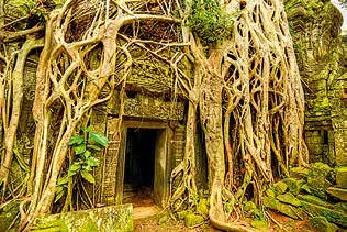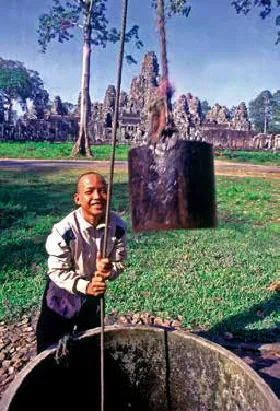吴哥
——诸神之所
吴哥
——诸神之所
吴哥王朝曾统治中南半岛南端的大片土地。大卫·博登游览柬埔寨著名的吴哥遗址时,发现吴哥王朝的衰落仍是考古学上的未解之谜。
1、 3. Overgrown temple Ta Prohm.
塔普伦寺置身于盘根错节的树丛中。
2. Relief sculptures of Apsaras.
吴哥窟的阿普萨拉女神浮雕。
4. Epic relics of Angkor Wat.
史诗般的吴哥遗迹。


While Cambodians will never forget the darkness of civil unrest which affected the country in recent years, they are rebuilding with tourism being central to its economic growth and the Angkor site being the jewel in the empire. The UNESCO World Heritage Site of Angkor now attracts travellers from across the globe.
Siem Reap, the town adjacent to Angkor, offers a full range of accommodation, shopping, dining, recreation and venues to party and there is a vibrant holiday atmosphere especially around 'Pub Street'.
Harnessing of Water
During the peak of the Khmer Empire, Angkor was the dominant civilisation in the whole of South East Asia. The society was a hydrological one based upon the harnessing of water to grow crops on the plains around the large inland lake known as Tonle Sap. The Mekong River flows into the lake and it often floods when melting Himalayan snow flows all the way down the river from its headwaters. When
this happens, the forests around the lake flood and provide a valuable spawning ground for fish. Khmer civilisation thrived through wise use of natural resources sourced from the forests, the floodplains and the waters of the river and lake. They even built huge water catchments called barays for storing water to irrigate crops during the dry season.
Water, religion and agriculture were essential components of this civilisation and visitors to the temples can see these elements of ancient Khmer life recorded in the bas-reliefs (three-dimensional engravings) etched on to the temple walls. Celestial dancers or apsaras are also carved into many of the walls.
Some archaeologists suggest that Angkor's decline was possibly linked to the neglect or failure of the irrigation system. Others suggest that the rise in of neighbouring powers, including the sacking of Angkor by the Thais in 1431, led to the decline in the territory under the control of the Khmer Empire.
承受着多年内乱带来的伤痛,柬埔寨人民努力复兴国家,重点发展旅游业,视吴哥遗址群为国之瑰宝。1992 年,吴哥遗址群被联合国教科文组织列为世界文化遗产,如今,此地吸引了大批来自世界各地的游客。

以水兴国
高棉帝国鼎盛时期,吴哥主导了整片东南亚地区的文明。本地人民利用洞里萨湖的水在湖周围的平原种植玉米。洞里萨湖常常暴发洪水,附近的森林被淹后成为养鱼的绝佳之地。通过对森林、涝原、河湖等自然资源的合理利用,高棉文明得以繁荣。
水、宗教及农业是高棉文明的核心元素。游客参观本地寺庙时,可以欣赏到庙墙上的浅浮雕,这些浅浮雕刻画了融入高棉文明核心元素的古高棉生活。




1. Geese at Bayon Temple.
巴戎寺前的鹅。
2. A monk at a well at Bayon Temple.
取水的和尚。
3、4. Kids on buffalo cart, Siem Reap.
在牛车上玩耍的孩子们。
Temples of Life
The Angkor temples never lost their function as monks and pilgrims continued to use some of them for worship even after the decline of the Khmer Empire in the 14th century. In 1860, French naturalist Henri Mouhot sparked renewed interest in the temples when he became the first recorded European to set eyes on the temples of the gods. His efforts and those of later archaeological teams reclaimed the temples from the encroaching jungles.
Today, the struggle to preserve the monuments from weathering and vandalism is ongoing. Under the co-ordination of the United Nations agency, UNESCO and the Cambodian Ministry of Culture, many local and foreign agencies are working towards preserving the monuments.
The first temple to be restored was Angkor Wat, the most famous of all the temples. The temple is the most significant of all and it's the world's largest religious site covering an area of 200 ha. Construction was initiated by King Suryavarman 11 in the first half of the 12th century with the massive sandstone structure protected by a large moat.
There are many faces to Angkor Wat depending upon the season and the time of day. During the wet season a small depression within the grounds fills with water and presents a spectacular reflection for photographs. When viewed from the front entrance it looks sparsely vegetated but from the air or the elevated temple of Phnom Bakheng, the surrounding forests are more evident.
Angkor Wat, however, isn't the only attraction in Angkor as visitors quickly realise. Each Khmer king built new monuments and established minicities with the Bayon Temple considered one of Cambodia's finest monuments. Built by King Jayavarman V11 in the 12th century, The Bayon is located in the centre of the last city of Angkor Thom.
Ta Prohm Temple has been left as it was found by Henri Mouhot. The ruins of this 'Indiana Jones' temple rise above the encroaching jungle to make it a favourite for many visitors. This temple was left by archaeologists to show visitors what it looked like when Mahout first saw Angkor. Tree roots entwine around the temple and the compound walls like anoctopus with the temple featuring in the Angelina Jolie movie, Lara Croft Tomb Raider.

While small, the Elephant Terrace near the Temple of the Leper King is one of the best restored monuments. Local Khmer archaeologists and artisans with the assistance of foreign experts meticulously reassembled this part of the Angkor jigsaw puzzle. Other important temples include Preah Khan, Banteay Srei and
Phnom Bakheng.
As there are over 100 major monuments scattered over 310 km2of the Angkor
floodplains, mobility is important. Several days should be allocated to visiting the essential monuments and, of the accessible temples; about 20 are rated 'must-see'.
Raising the Bar
Being the tourist town that Siem Reap is, there's a vibrant dining and bar culture that for many visitors is almost as exciting as the ancient temples. The area around the Old Market has become known as 'Pub Street' with Angelina Jolie's favourite bar being the Red Piano Bar. The famous Hollywood actress was in town again recently to film her latest movie called First They Killed My Father.
As inviting as the Red Piano Bar is, there are many other watering holes along Pub Street and it's not hard to find a venue or two for a great night out. Some other enticing bars serving decent beer at low prices include the The Sun, Asana Bar, Miss Wong Cocktail Bar, Charlie's Bar, Angkor What and the Foreign Correspondents Club (FCC).
1. A remorque driver resting, Siem Reap.
打盹中的人力车夫。
2. Pub street, Siem Reap.
暹粒的酒吧街。


Khmer Cuisine
Cambodia's chequered history took its toll on the people and the land. Much of the country's cultural heritage was destroyed and even Khmer cuisine was suppressed as recipes were obliterated, kitchens destroyed and intellectual exchange stifled. Today, there's a growing resurgence in Khmer cuisine and Siem Reap has several restaurants serving local dishes.
Try dishes like amok (minced fish with lemongrass and coconut), lemongrass soup, Khmer pancakes, spring rolls, fish with mango sauce and, pomelo salad with chicken. Savour desserts like local fruits and a cendol-like offering and wash it all down with Angkor beer.
So a night out in Siem Reap need not just involve bar-hopping. There are many excellent restaurants serving Khmer and a smorgasbord of international cuisines. Visit Cuisine Wat Damnak (Khmer fusion), Chanrey Tree, Haven and Dakshin's. There are also many karaoke lounges to see the night out.
Many visitors find time before a meal to shop in and around the Old Market which is one of the best places for souvenirs such as Mondulkiri coffee, Kampot pepper, scarves and Khmer silk. DFS Gallerie has just opened near the Angkor Museum to offer a range of luxurious duty-free items.
Fairways for the Gods
Cambodia is rapidly capturing the attention of regional golfers and with three courses in Siem Reap, seven courses in Phnom Penh and another on Koh Rong, an island off the country's south, Cambodia is definitely an emerging golf destination.
The Angkor Golf Resort is an 18-hole championship course designed by former world number one Nick Faldo. It has arisen from the vast padi fields that surround the historic town and protected site of Angkor. The 7,239-yard, par 72 layout was designed by Nick Faldo with the second and the 13th holes being considered the most memorable.
Phokeethra Country Club, managed by Sofitel is the most established course and was the home of the Johnnie Walker Classic in 2009 and the 2010 Cambodian Open. Opened in 2007 the tenth hole features the restored Roluh Bridge dating back to Angkor times. This 7,145 yard, 18-hole course has sweeping fairways and generous greens.
Siem Reap's most recent course is the Booyoung Country Club of 7,114 yards. This 18-hole, par 72 course was laid out by well-known Japanese designer Kentaro Sato and features luxurious course-side accommodation plus wide and flat fairways with large greens.
8.多元价值观冲突导致信仰危机。学生无法在短时间内认清各种价值观的本质,做出正确的价值判断,他们更多地只是关心自身的发展状态,追求个人的利益和尊严,在多元文化背景下出现了信仰危机。
神庙重生
高棉帝国衰亡后,吴哥王城渐渐湮没在丛林之中。1863 年,法国博物学家亨利·穆奥在吴哥发现古庙遗迹,惊为天人。他发表的游记及后来考古队的努力使丛林中的古庙重获世人瞩目。
时至今日,柬埔寨政府及一些国内外组织仍在协力保护这些建筑免受自然因素和人为因素的破坏。
第一座得以修复的寺庙是遗址群中最著名的吴哥窟。该寺被誉为柬埔寨的国宝,是世界上最大的庙宇,占地约2平方公里。吴哥窟由苏利耶跋摩二世于12世纪上叶兴建,全部用砂岩重叠砌成,四周有城壕环绕。
观赏的时间、角度不同,吴哥窟展现的风姿也不同。每逢潮湿季节,可以在洼地的积水中欣赏到寺庙宏伟的倒影。寺庙旁的草木,若从前门看去显得较为稀疏,从上空俯瞰却郁郁葱葱。
吴哥窟并不是唯一引人入胜的景点。每代高棉国王都会建造寺庙、王城,其中,由苏利耶跋摩一世始建、阇耶跋摩七世重建的巴戎寺,位于吴哥通王城中心,是柬埔寨寺庙建筑的典范之作。
从丛林中拔地而起的塔普伦寺是很多游客的最爱。该寺因与树根茎干纠缠盘结而被考古学家放弃整修,保持了原始模样。安吉丽娜·朱莉主演的《古墓丽影》就在塔普伦寺取了著名的“树包屋”镜头。
作为旅游重镇的暹粒,拥有充满活力的餐饮、酒吧文化,吸引了大量游客。老市场附近的片区被称为“酒吧街”,街上有很多富于魅力的酒吧,想找几个地方过个精彩的夜生活并不难。有些酒吧甚至以一星的价格提供五星品质的啤酒。
柬埔寨的动乱使很多高棉美食的食谱失传。如今,高棉美食重现世间,暹粒就有多家餐厅提供本土特色菜肴。在这里可以尝到 amok(碎鱼肉或鸡肉加入柠檬草、椰汁等配料)、柠檬草汤、高棉薄饼、鱼配芒果酱等美食。若用吴哥啤酒搭配本地水果或珍多冰,滋味妙不可言。
TRAVEL FILE 小贴士
Getting There 交通
China Southern Airlines flies daily from Guangzhou to Siem Reap International Airport.

Where to Stay 住宿
Amansara (www.aman.com), Angkor Miracle Resort and Spa (www.angkormiracle. com), Belmond, Grand Hotel d'Angkor (www.raffles.com) and Hotel Sofitel Angkor Phokeethra Golf and Spa Resort (www.sofitel.com).
AUSTRALIAN WINE, A NEW LEGEND
Australia produces one billion litres of wine annually, 200 million of which are consumed domestically. It is such an enjoyment for Australians to sip a glass of wine in a bar after work, or take a bottle back home.
Text by Bai He Photos by Getty Images Translation by Leo
Australia, a lonely continent in the Southern Hemisphere, is teeming with all varieties of grape. Thanks to abundant sunshine, grapes are thriving on the vines with exuberant vitality. Endowed with exceptionally favourable climate and environmental conditions, the land produces wine that has quickly gained popularity among younger generations around the world.
Adelaide, the capital of the state of South Australia, was built under the concept of creating a beautiful and health-promoting city. Stretching from the desert at its northern extent to the beaches in the south, the city has a geographic characteristic that resembles that of the world's finest wine-producing region - Bordeaux in France.
However, unlike European wine-producing regions where the winemaking business still works in a more traditional farm-based style, Australian wineries often operate like factories where winemaking processes are quantifiable and measurable by modern equipment and technology. Australian wine producers see themselves more as professionalwinemakers or winery managers than winemaking artists.
Such characteristics are closely related to the geographic conditions and historical traditions of the country. Constant climates and ample sunshine ensure that the quality of local grapes do not vary much from one year to another. Having a short wine-producing history of less than 200 years, Australian winemakers are not hedged in by as many rules and restrictions. Plus, the spirit of inclusion, innovation and simplicity that this country of immigrants embraces have also helped make winemaking a significant industry in the nation.
——柬埔寨吴哥文化艺术

